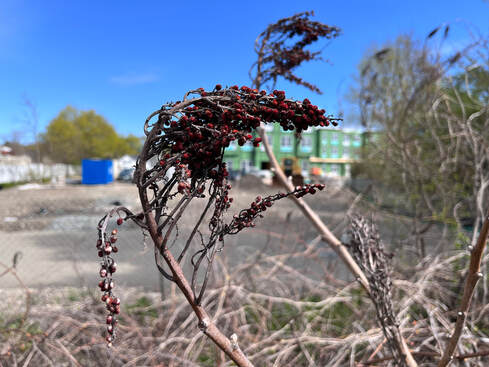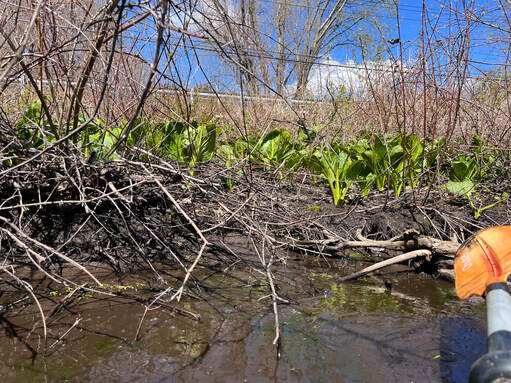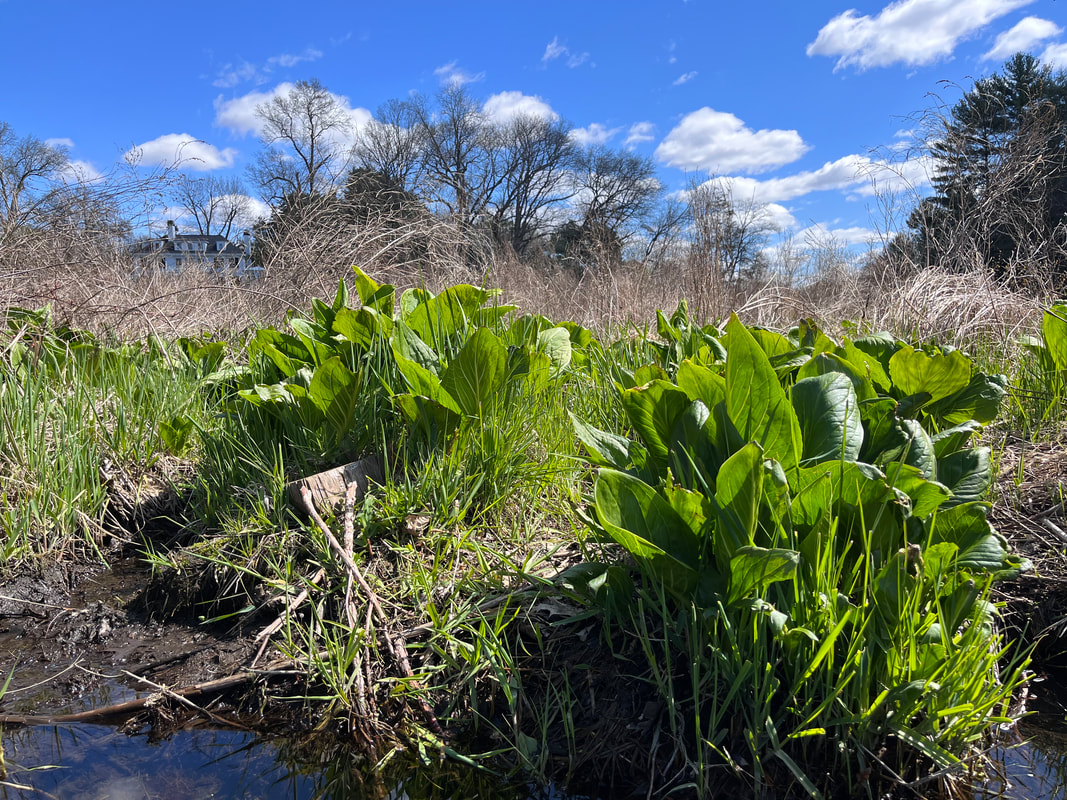 A native Staghorn Sumac hopefully surviving on the boundary between new construction and a landscaped lawn. A native Staghorn Sumac hopefully surviving on the boundary between new construction and a landscaped lawn. As some of you know from an earlier post, one of the things I am doing to connect with nature is spending time on the river across the street from my house. The plan is the engage in close observation. This project brought me into closer-than-usual contact with skunk cabbage. I watched Symplocarpus Foetidus over the course of a couple weeks. It was always on the list because–it being early spring–there were few plants available along the banks of the Charles River where I live outside of Boston. The most prolific early grower in my area of observation, in fact, was the “burning bush” (Euonymus Alatus) an invasive that is now illegal to sell in Massachusetts and New Hampshire because of the tenacious hold it has on the local environment. It came here as an ornamental for lawns and "gardens". Other landscaping staples like Rhododendron can be found along the banks as well. Some migrated, no doubt, and others were planted. Skunk cabbage, on the other hand, is indigenous to this part of the world. Perhaps ironically, part of my interest comes from the fact that it, too, has been banned or regulated in parts of Great Britain. Apparently context is everything with invasive species. They are survivors, which also attracted me. These days--much of the time--I and the people I know are thinking hard about survival. Economic crises, plagues, and war seem closer to us than they were before. Our human ecology is frayed and fraying. Taking the boat out to visit a species resisting the incursion of civilization is restful, even inspiring in ways.  Henry David Thoreau recognized this in his own observations. Writing in his journal on October 31, 1857, “If you are afflicted with melancholy at this season, go to the swamp and see the brave spears of skunk-cabbage buds already advanced toward a new year.” Along the river–even when the invasive burning bush is just beginning to awaken–the skunk cabbage is already well established. If the observer is in the right mood, it can be remarkable to look at. Its broad green leaves and alien flower evoke the times of the far past or far future. Its smell--designed to attract pollinators--is more rude than off-putting. Unlike most plants, the skunk cabbage is “thermogenic”, meaning it generates its own heat. This keeps much of the frost at bay, allowing it to establish itself in the wet areas of its habitat by spreading roots out and down for the majority of the year. This aspect–possibly more than its famous smell of rotting meat–is a key element to the survival of its habitat along riverbanks and other areas susceptible to erosion. My own observations, of course, did not cover its fall transformation, when the old leaves die off to reveal Thoreau’s “spears” underneath. However, I was able to see some of the benefits this provides the landscape. The approach for my observations--as I noted earlier--included regular trips by canoe or kayak out on the Charles to see how the cabbage and the ecosystem itself is doing in the human-dominated suburban community where I live. The role of the cabbage–particularly during this early spring part of the year, is a key element. It is easy to miss in many ways, but if one knows what to look for, the situation is quite clear. The Charles River (Its Algonquin name is “Quinobequin”) is a narrow, meandering body of water as it passes through Natick, MA where these observations occurred. On each side of the river at its widest points are large marshy areas that are home to a larger percentage of the wildlife that makes the Charles home. The tall grasses and brush rising out of these banks provides protection to at least two species of turtle as well as nesting areas for Blue Herons, Canadian (and feral) Geese, 3 observed species of duck, a mating pair of swans, amphibians in their various stages, and fish. There are also insects and songbirds in abundance. During this time of year the grasses have yet to recover from their winter. The wildlife conceals itself within the gray, dried remains of last year. The lone green–with its complex root system–belongs to the skunk cabbage.  I was careful when taking the above picture not to disturb any of the geese who were nesting in my proximity. However, it shows the very edge of the largest of these marshes which, in addition to providing habitat for wildlife, also are responsible for flood prevention, absorbing a large portion of the excess water we experience in March and April. The limited number of green grasses that can be seen around the base of the cabbage may actually be benefiting from the warmth of the cabbage itself. It is not unusual in the spring and fall for them to heat the ground enough to eliminate the frost layer nearest their roots, giving other species a head start as well. Just visible in the picture above is a large, white house. The Charles is not in a wild and remote place. Over 900,000 people live in its watershed. Even more commute into the area daily for work or other activities. This means the ecosystem must contend with air, water, light and noise pollution on a regular basis. There are human-made structures that disturb the flow of the river and the ability of plants to take root. There is toxic runoff from the street above. Those invasives abound. The invasive plants are mostly from a couple of centuries of home and public landscaping projects. Some invasive animals–like the red-eared slider turtle–are descendents of pets and were later released into the river when their novelty wore off. Others--like the rat--are opportunists. Some of these species play nice with the environment. Others do not. The skunk cabbage functions as part of the team of species keeping the river habitat together and is frequently able to make headway in places other species cannot. At the top of the first picture, in fact, one can see the barricade that indicates the presence of a major commuting road into Boston. Twice a day it is clogged with cars and trucks going to and from the city. However, just below, in the mud that has gathered around the foundations of that road are the skunk cabbages, helping to absorb sound, clean the water, and provide safe haven for the rest of the river community. They are hard to kill and impossible to remove, which is a problem in Britain. However, it is ideal for life on the Quinobequin, where it has always made its home.
0 Comments
Leave a Reply. |
Adam Tierney-EliotI am a full-time pastor in a small, progressive church in Massachusetts. This blog is about the non-church things I do to find spiritual sustenance. Archives
June 2024
Categories
All
|
 RSS Feed
RSS Feed